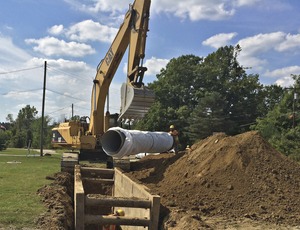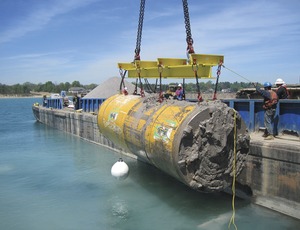Forces of nature as mighty as a polar vortex and as miniscule as endangered mussels haven't waylaid work on Michigan's $274-million Karegnondi Pipeline, a new raw-water conduit that will snake east from the banks of Lake Huron to treatment facilities in Genesee, Lapeer and Sanilec counties along its 67-mile trajectory. Once complete, Karegnondi will supply drinking water to more than 2,400 sq miles along Michigan's Interstate 69 corridor, drawing from Lake Huron at a rate of up to 85 million gallons per day. As they have already learned, project team members need to respond nimbly to whatever nature tosses in their tracks in order to complete the project by spring 2016.


In April, as Flint-based Karegnondi Water Authority (KWA) prepared to bid landside portions of the pipeline, the U.S. Environmental Protection Agency challenged a wetlands permit it contended threatened federally protected Northern Riffleshell mussels, a species residing in the bed of Sanilac County's Black River.
At issue was whether crews would be allowed to perform open cuts, a method that allows pipeline to be laid a section at a time by temporarily diverting water, or be compelled to tunnel beneath the river, adding complexity to the project.
By June, KWA and Saginaw, Mich.-based environmental consultant Spicer Group convinced regulators that open cutting was less disruptive to the species, requiring only "two weeks to get in and get out as opposed to the eight weeks tunneling could have required," says KWA deputy CEO John O'Brien. By mid-July, Zito Construction, Grand Blanc, Mich., began installing 36-in.-dia ductile iron Class 150 pipe along a 14-mile stretch from Genessee to Lapeer counties.
Harnessing a Caterpillar model 350 excavator to trench and lay pipe, a crew of 15 has progressed at rates of up to 850 ft per day. In August, however, operations ground to a halt after workers unexpectedly encountered a 700-ft-long stretch of peat moss.
"The concern is the pipe will sink," says Mike Wine-gard, vice president with Chicago-based engineer AECOM, which is serving as program manager for the project with Detroit-based Wade Trim. "One solution is to drive piers down to good soil and place pipe directly atop them." As the design team mulls it options, Zito has "gapped the spot" and continued its trek west.
In October, work is scheduled to begin on a 12-mile stretch of 60-in.-dia pipeline extending through Sanilec County. How long either operation will continue is an open question. "Two years ago, I would have said, yes, there's a chance we could work through winter," says O'Brien."Then, last year, everything shut down from fall to spring."
As a result, Buffalo, N.Y.-based contractor Bidco Marine Group was unable to begin work on lakeside portions of the project slated for last fall, including installation of 72-in.-dia reinforced concrete transmission pipe to be fed by 60-in.-dia dual inlets.
"To hedge our bets, we always envisioned this as a two-season operation," says Winegard. "The thinking was what wasn't completed last fall would resume the following spring."
Even then, conditions were slow to improve. Divers due to assist in laying 72-in.-dia intake pipe on the floor of Lake Huron had to wait a month, from May to June, before caps of ice, remnants of winter's polar vortex, were in full retreat.

Post a comment to this article
Report Abusive Comment